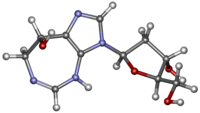Pentostatin
 | |
 | |
| Clinical data | |
|---|---|
| Trade names | Nipent |
| AHFS/Drugs.com | Monograph |
| MedlinePlus | a692004 |
| Routes of administration | Intravenous |
| ATC code | |
| Legal status | |
| Legal status | |
| Pharmacokinetic data | |
| Bioavailability | n/a |
| Protein binding | 4% |
| Metabolism | Hepatic, minor |
| Elimination half-life | 2.6 to 16 hours, mean 5.7 hours |
| Identifiers | |
| |
JSmol) | |
| |
| |
| (verify) | |
Pentostatin (or deoxycoformycin, trade name Nipent, manufactured by SuperGen) is an anticancer
Mechanism
It is classified as a
It mimics the nucleoside adenosine and thus inhibits the enzyme adenosine deaminase, interfering with the cell's ability to process DNA.[3]
Cancer cells generally divide more often than healthy cells; DNA is highly involved in cell division (mitosis) and drugs which target DNA-related processes are therefore more toxic to cancer cells than healthy cells.
Uses
Pentostatin is used to treat hairy cell leukemia.[4] It is given by intravenous infusion once every two weeks for three to six months.
Additionally, pentostatin has been used to treat steroid-refractory acute and chronic graft-versus-host disease.[5]
Pentostatin is also used in chronic lymphocytic leukemia (CLL) patients who have relapsed.
